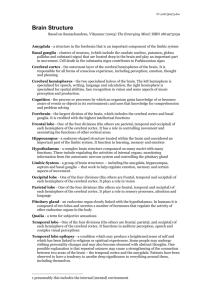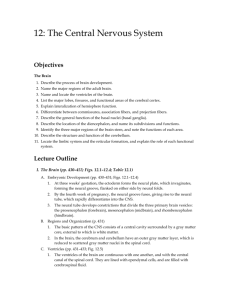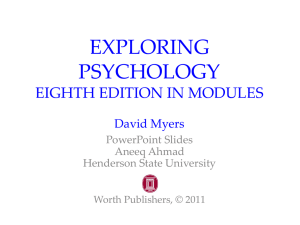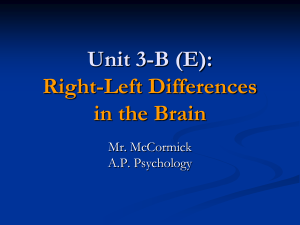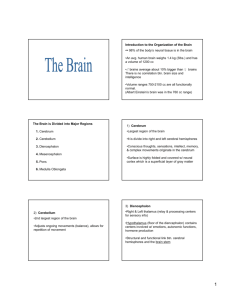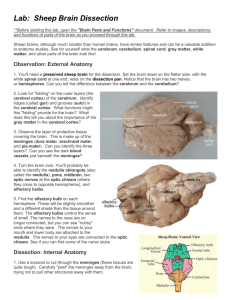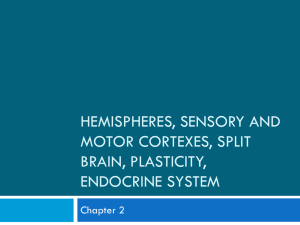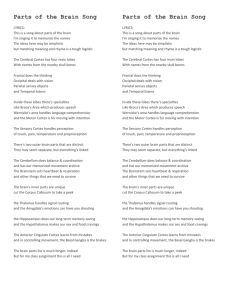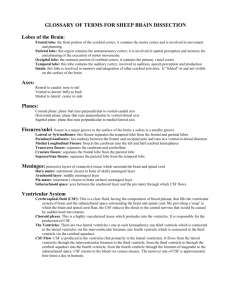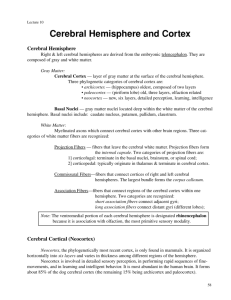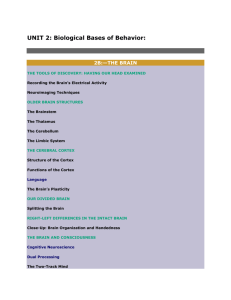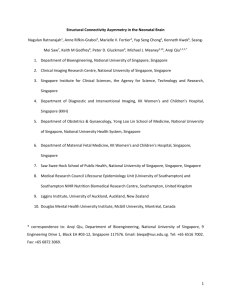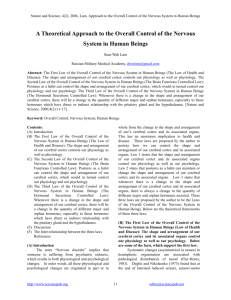psychology - the brain and behaviour
advertisement
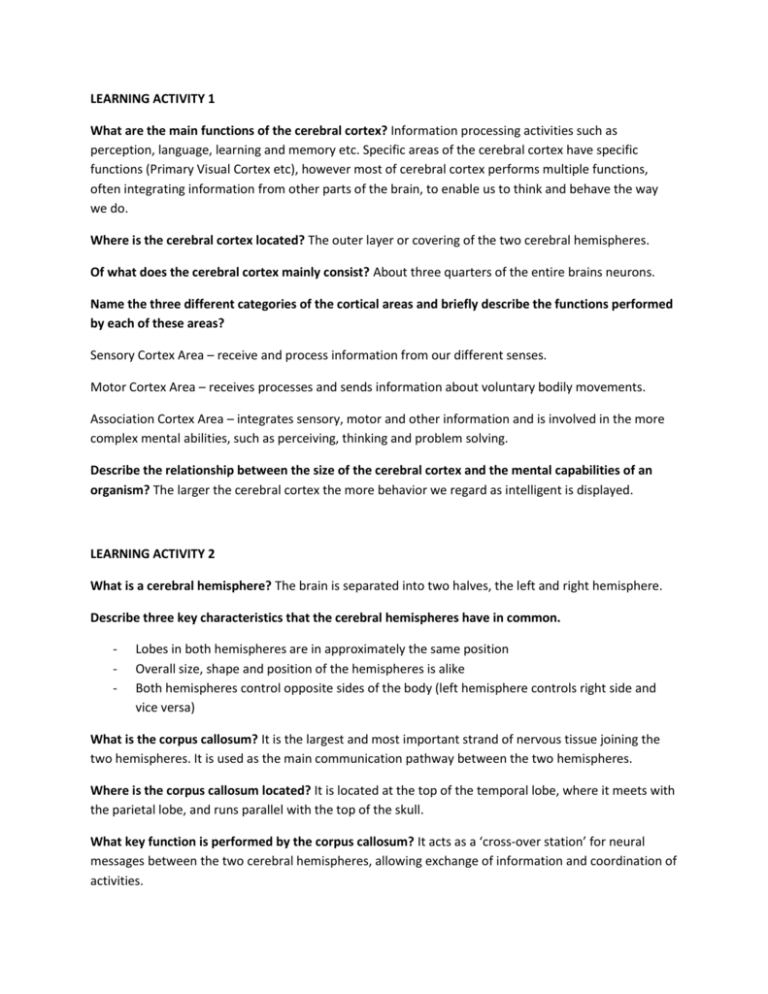
LEARNING ACTIVITY 1 What are the main functions of the cerebral cortex? Information processing activities such as perception, language, learning and memory etc. Specific areas of the cerebral cortex have specific functions (Primary Visual Cortex etc), however most of cerebral cortex performs multiple functions, often integrating information from other parts of the brain, to enable us to think and behave the way we do. Where is the cerebral cortex located? The outer layer or covering of the two cerebral hemispheres. Of what does the cerebral cortex mainly consist? About three quarters of the entire brains neurons. Name the three different categories of the cortical areas and briefly describe the functions performed by each of these areas? Sensory Cortex Area – receive and process information from our different senses. Motor Cortex Area – receives processes and sends information about voluntary bodily movements. Association Cortex Area – integrates sensory, motor and other information and is involved in the more complex mental abilities, such as perceiving, thinking and problem solving. Describe the relationship between the size of the cerebral cortex and the mental capabilities of an organism? The larger the cerebral cortex the more behavior we regard as intelligent is displayed. LEARNING ACTIVITY 2 What is a cerebral hemisphere? The brain is separated into two halves, the left and right hemisphere. Describe three key characteristics that the cerebral hemispheres have in common. - Lobes in both hemispheres are in approximately the same position Overall size, shape and position of the hemispheres is alike Both hemispheres control opposite sides of the body (left hemisphere controls right side and vice versa) What is the corpus callosum? It is the largest and most important strand of nervous tissue joining the two hemispheres. It is used as the main communication pathway between the two hemispheres. Where is the corpus callosum located? It is located at the top of the temporal lobe, where it meets with the parietal lobe, and runs parallel with the top of the skull. What key function is performed by the corpus callosum? It acts as a ‘cross-over station’ for neural messages between the two cerebral hemispheres, allowing exchange of information and coordination of activities. LEARNING ACTIVITY 8 LOCATION FUNCTION LINKS TO OTHER BRAIN AREAS EFFECTS OF DAMAGE BROCA’S AREA Left frontal lobe next to the motor cortex. Controls the muscles of the face, tongue, jaw and throat to produce articulate speech. Also involved with understanding grammatical structure of a sentence. Wernicke’s area, Auditory Cortex Language loss and impairment (Broca’s Aphrasia). Often produces speech that is very deliberate, consisting of a few words with a very simple grammatical structure, but rarely total loss of speech. WERNICKE’S AREA Left temporal lobe next to the primary auditory cortex. Involved with comprehension of speech. Word is heard and processed by primary auditory cortex but is only understood once processed by Wernicke’s area. It is also involved with locating appropriate words from memory to express feeling. Broca’s area, auditory cortex Can speak fluently, but speech is largely meaningless. LEARNING ACTIVITY 10 Explain the meaning of the term hemispheric specialization. Whilst the functions performed by the sensory and motor areas of the left and right cerebral hemispheres are generally the same, each hemisphere also has some specialized functions that are not duplicated in the other hemisphere. COGNITIVE FUNCTIONS BEHAVIOURAL FUNCTIONS LEFT HEMISPHERE Logical Reasoning, analysis Verbal tasks RIGHT HEMISPHERE Creative thinking Spatial Construction Identify the cerebral hemisphere (left or right) that specializes in the cognitive and behavioural functions listed below. a) b) c) d) e) Appreciating the beauty of a forest – right Judging whether a car will fit into a parking space – right Kicking a football with the left foot – right Listening to someone speak – left Applying logic in an argument – left f) g) h) i) j) k) l) m) n) o) Working out if you have enough money for a holiday – left Daydreaming about being rich and famous – right Finding your way through a maze – right Speaking on the telephone – left Playing a simulated golf game on a computer – right Working out the meaning of a grin on someone’s face – right Arranging a bouquet of flowers – right Giving someone the correct change for their purchase – left Recognising classmates from an old class photo – right Working out when you have to get up in the morning to get to school on time – left LEARNING ACTIVITY 12 Explain the difference between invasive and non-invasive brain research methods. Invasive brain research involves physically invading the brain, hence the name. Non-invasive brain research methods involve conducting experiments, without invading, to discover the workings of the brain. Briefly describe two ethical issues that may be involved with invasive research methods. The dangers involved with the physical invasion of the brain, and the potential dangers to other areas of the brain (other than the part removed etc) What is the meaning of the term intact brain? Intact brains are brains that are fully functional and healthy. Briefly describe the Wada test and explain how it can be used to study hemispheric specialization in people with intact brains. An anesthetic is injected into an artery in the patient’s neck so it shuts down one cerebral hemisphere. As the anesthetic is being injected the patient raises his arms and begins to count. Once the anesthetic kicks in the patient will drop his arm, (opposite to hemisphere affected), then the patient stops counting. If the hemisphere affected by the drug is the one that controls speech then the patient will not be able to start counting. It can be used to study intact brains, in particular the regions of the brain that control speech. Briefly describe the tachistoscope procedure and explain how it can be used to study hemispheric specialization in people with intact brains. Images are flashed onto a screen, whilst the subject fixates on a cross or dot in the centre of the screen. Non-verbal (pictures etc) are projected to the right hemisphere, where it is processed and recognized quicker than when the picture is presented to the left hemisphere. This is because the non-verbal processing is controlled by the right hemisphere. It can be used to indicate the level of dominance of the hemispheres.

